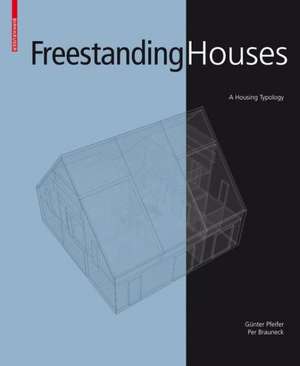Freestanding Houses: A Housing Typology
Autor Günter Pfeifer, Per Braunecken Limba Engleză Paperback – 15 oct 2009
Preț: 132.87 lei
Nou
Puncte Express: 199
Preț estimativ în valută:
25.42€ • 26.62$ • 21.04£
25.42€ • 26.62$ • 21.04£
Carte indisponibilă temporar
Doresc să fiu notificat când acest titlu va fi disponibil:
Se trimite...
Preluare comenzi: 021 569.72.76
Specificații
ISBN-13: 9783034600736
ISBN-10: 3034600739
Pagini: 120
Ilustrații: 120 p. 250 illus.
Dimensiuni: 230 x 280 x 13 mm
Greutate: 0.66 kg
Ediția:2010
Editura: Birkhäuser Basel
Colecția Birkhäuser
Locul publicării:Basel, Switzerland
ISBN-10: 3034600739
Pagini: 120
Ilustrații: 120 p. 250 illus.
Dimensiuni: 230 x 280 x 13 mm
Greutate: 0.66 kg
Ediția:2010
Editura: Birkhäuser Basel
Colecția Birkhäuser
Locul publicării:Basel, Switzerland
Descriere
The freestanding house is not, strictly speaking, a typological category of housing. While in the previous volumes in the series – row houses, courtyard houses and town houses – the focus lay on typological ?oor plan arran- ments, here the term "freestanding" refers to an urban typological category. This marks a ?rst fundamental difference to the other volumes in the series. Freestanding houses can be categorised according to their type of access, orientation and spatial organisation, but as these categories reoccur in new formations, they cannot be regarded as true typological characteristics. An examination of freestanding houses, therefore, refers less to typological ?oor plan characteristics, focusing instead on the issue of structural integ- tion at an urban level. But here we are faced with a seemingly irresolvable con?ict: urban spaces cannot be formed with freestanding houses alone. The freestanding house wants to be as independent as possible, will not fall into line and resists typological classi?cation. This explains, perhaps, why the freestanding house is still viewed by many as an ideal way of living. Standing on its own, it embodies the desire for maximum possible freedom and independence. Although we have long been aware that the promise of autonomy is more illusion than reality, from a psychological point of view, the feeling of indiv- ualism is perhaps a decisive factor for the popularity of the "freestanding house".
Cuprins
The typology of the freestanding house.- Floor plan types.
Notă biografică
Günter Pfeifer is a professor of design and residential building at the Technische Universität Darmstadt (Darmstadt University of Technology). As a practicing architect he has worked with Frank Gehry, Zaha Hadid, Tadao Ando, Alvaro Siza, and others. He taught design and building construction for ten years and is active today in the intelligent, energy-saving, sustainable development of existing building types.
Dipl.-Ing. Per Brauneck is a teacher and researcher at the Technische Universität Darmstadt (Darmstadt University of Technology).
Together they have already published the book Exposed Concrete: Technology and Design (Birkhäuser Verlag).
Dipl.-Ing. Per Brauneck is a teacher and researcher at the Technische Universität Darmstadt (Darmstadt University of Technology).
Together they have already published the book Exposed Concrete: Technology and Design (Birkhäuser Verlag).
Caracteristici
Highlights the variety of possible types as a resource for housing construction
The ideas and approaches are a treasure trove for every residential architect
Contains precise, systematic presentations, including newly developed drawings
The ideas and approaches are a treasure trove for every residential architect
Contains precise, systematic presentations, including newly developed drawings
